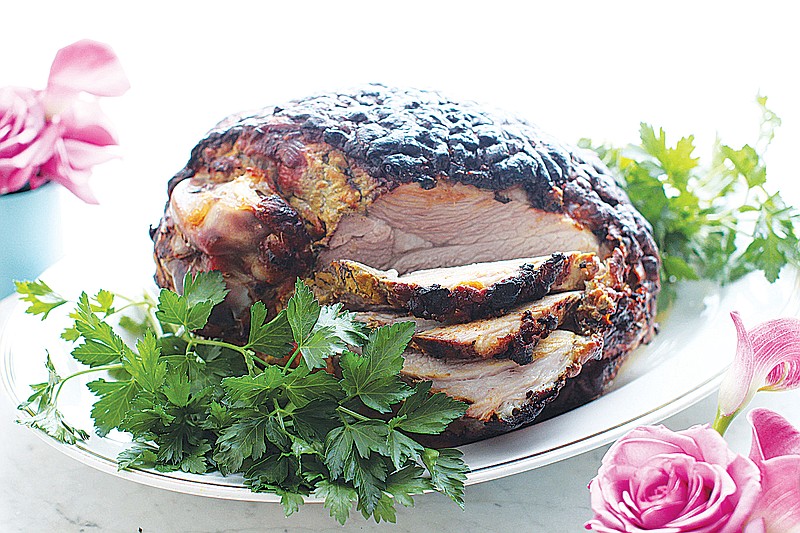With warm weather sneaking in these days, it's OK to start thinking about using your grill.
And with Easter in a few days, why not think about roasting your Easter ham on the grill? It's deceptively easy. All you really need is the forethought to order a fresh ham from your butcher (many grocers don't normally stock them) and the patience to let it cook slowly over indirect heat.
A fresh ham, sometimes called a "green" ham, is pork at its most basic -- not cured, not smoked, not cooked. The meat is so sweet and succulent, and the texture is meaty, not compact and slick as a cured ham often is. Also, the meat of a fresh ham remains white when cooked.
The preparation is quite simple and decidedly old-fashioned. Don't be tempted to switch the yellow mustard for Dijon. In this instance, yellow is better. The combination of yellow mustard and dark brown sugar forms a heady crust that is punctuated by the whole cloves that dot the natural fat cap on the ham.
Some people leave both the skin and the fat intact, but removing the skin and leaving just the fat on the ham allows the mustard/ brown sugar/salt slather to better infuse the meat. And the deeply caramelized crust you get from the long cooking time is something that you want on as many slices as possible.
Depending on where you live, you may need to order the ham up to a week in advance. You also can also ask the butcher to skin the ham for you, but make sure you ask that the fat be left intact.
Fresh Ham with Cloves and Brown Sugar
Prefer to roast this in the oven? Follow the recipe as directed, but set the ham on a foil-lined rimmed baking sheet. Roast at 325 degrees for 5 to 6 hours.
12- to 15-pound fresh (uncured, unsmoked) ham (bone-in leg of pork)
2 tablespoons whole cloves
1/2 cup packed dark brown sugar
1 1/2 tablespoons kosher salt
9-ounce jar yellow mustard
Prepare a grill for medium heat, indirect cooking. For a charcoal grill, this means banking the hot coals to one side of the grill and cooking on the other side. For a gas grill, this means turning off one or more burners to create a cooler side, then cooking on that side.
Use paper towels to pat dry the ham. Using a sharp boning or paring knife, remove the skin but leave the layer of fat just beneath the skin (alternatively, you can have the butcher do this). Score the fat by making diagonal cuts from right to left, then again across the original cuts to create a diamond pattern. Press a whole clove into the points of each of these diamonds.
In a small bowl, mix together the sugar, salt and mustard. Rub the mixture all over the exterior of the ham.
Place the ham on the cooler (indirect heat) side of the grill, either directly on the grates or in a V-rack roast holder. Grill the ham for 5 to 6 hours, or until the thickest part reaches 175 to 180 degrees. The outside should be darkly caramelized and the inside should be very tender.
Transfer the ham to a serving platter and let rest for 20 minutes before carving.
Start to finish: 6 hours (30 minutes active). Servings: 15 to 20 (depending on size).
